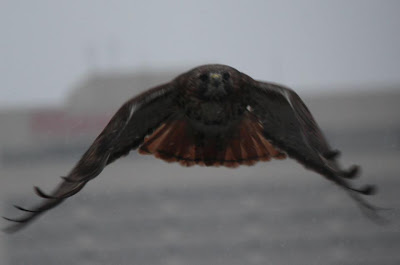All is well on the nest. Mom and T2 are doing a fine job with incubating their eggs. It's getting close to the end of incubation, and hatching may start sometime this week.
Here's what's been happening over the past couple of weeks.
Things got a little crazy down on Winter Street earlier this month. A dumpster suddenly appeared in the parking area where hawkwatchers often gather, then machinery, another dumpster, a sand pile - a pop-up construction site.
Marjorie Goodman
It turned out to be the start of a project to replace gas mains in the area. The parking meters were also removed, replaced by a parking kiosk. The contractor told Carolyn Sutton that none of the trees below the nest will be harmed. These trees are essential for successful fledging as they are usually the first landing spot out of the nest for the eyasses. The nest is in the topmost window on the extreme left of this image.
Carolyn Sutton
Everything apparently will be put back in good order when they leave at the end of July. As the week went on, however, the construction site suddenly started to vanish as fast as it had appeared.
Katy Mae
We surmise that this sudden change in plans was because of the huge Philadelphia Science Festival that engulfed the streets around the Franklin Institute, including Winter Street.
Alec Rogers
The hawks sat serenely above it all, watching their streets fill with tents and pedestrians, and their skies invaded by a blimp.
Hawk cam watchers have enjoyed watching the changeover between the hawks when they switch places on the eggs. This is when we get the best view of those eggs.
Tess Cook
T2 can now add incubation to his string of new accomplishments. He has become a real pro! After he has been sitting for a while...
Della Micah
... he will stand up...
Della Micah
... lean over and start turning and rotating the eggs...
Della Micah
... so that the warmth from his body is transmitted evenly over the developing embryos inside the eggs.
Della Micah
Then he settles back down again, patiently awaiting the return of the formel.
Della Micah
Mom, meanwhile, enjoys some me-time away from the nest in her favorite tree.
Carolyn Sutton
Her brood patch is visible here below her lowered head.
Carolyn Sutton
It must feel good to get off those eggs for a bit...
Carolyn Sutton
... and have a good stretch and preen.
Carolyn Sutton
Whenever she is away from the nest, she always has it in her sight line. A favorite spot is the lamp pole beside the Vine Street expressway.
Carolyn Sutton
Sometimes, she turns her back for a while...
Kevin Vaughan
... but as relaxed as she can seem one moment...
Kevin Vaughan
... if she spots possible prey down below in the grass, she goes on high alert in an instant.
Kevin Vaughan
If T2 is in the vicinity, he will be watching the nest.
Kevin Vaughan
...even when it's wet and windy...
Kevin Vaughan
... mohawk weather!
Kevin Vaughan
OK - the good news is that T2 started to catch prey that is larger than a vole. The bad news: that prey was a yellow gosling (baby goose). Let's hope the goose cam was down that morning....
Both hawks looked slightly startled at what T2 had just brought in to the nest.
Kevin Vaughan
Mom clearly realized this was a breakfast bonanza, and that sharing was not an option.
Kevin Vaughan
She took off from the nest, and flew right over us with the gosling's webbed feet dangling, and headed for the Barnes Museum roof.
Kevin Vaughan
This was the moment when we had to keep muttering, "Circle of life, circle of life...." as she ripped into the fluffy, yellow carcass....
Kevin Vaughan
... scattering downy feathers on the breeze.
Katy Mae
It serves as a reminder of how miraculous it was last spring that she allowed T2 anywhere near the nest with the week-old eyasses there, given his (and any hawk's) predilection for helpless fluffy creatures as a food source.
On a gentler note, we think we have figured out why the hawks keep bringing those round seed pods to the nest. Here's Mom arriving with a pod. This is one of Kevin Vaughan's most beautiful images with the sun-caught shadow hawks bookending her.
Kevin Vaughan
The seed pods come from London plane trees, also known as sycamores.
Katy Mae
Though they are hard and prickly on the outside, looking like tiny hedgehogs suspended from the branches, when you break open the pod, the seeds create mounds of fluff...
Katy Mae
... which puff up into even softer piles when teased apart. Could there be a more inviting nest lining for the eggs' precious cargo?
So in the next few days, the eggs should start pipping - the first sign of an imminent hatch for this marvelous pair of hawks who are about to embark on raising T2's first eyasses.
Katy Mae
With my computer woes now fixed, I plan to keep you right up to date with all the eggcitement!






















.jpg)




























































